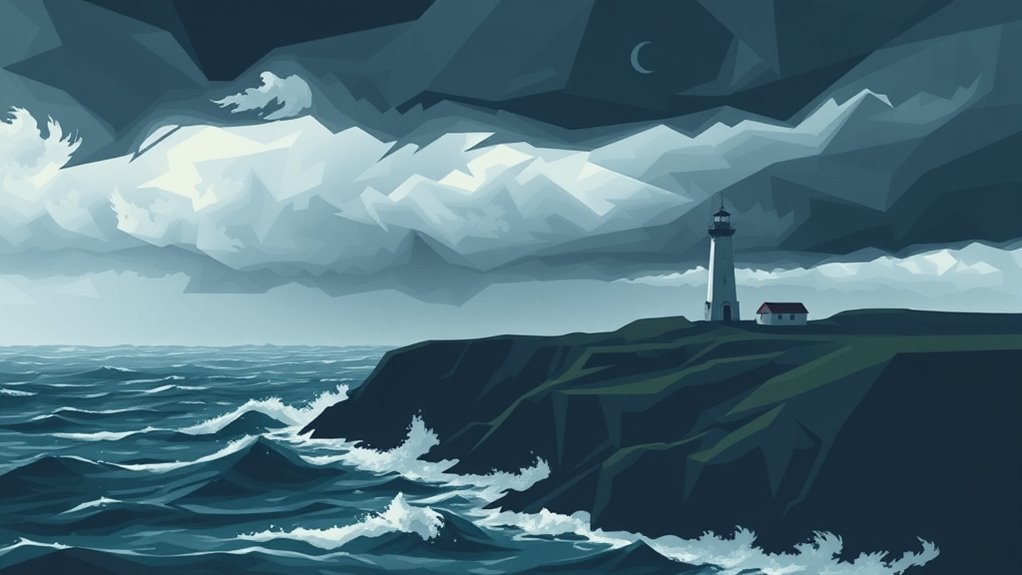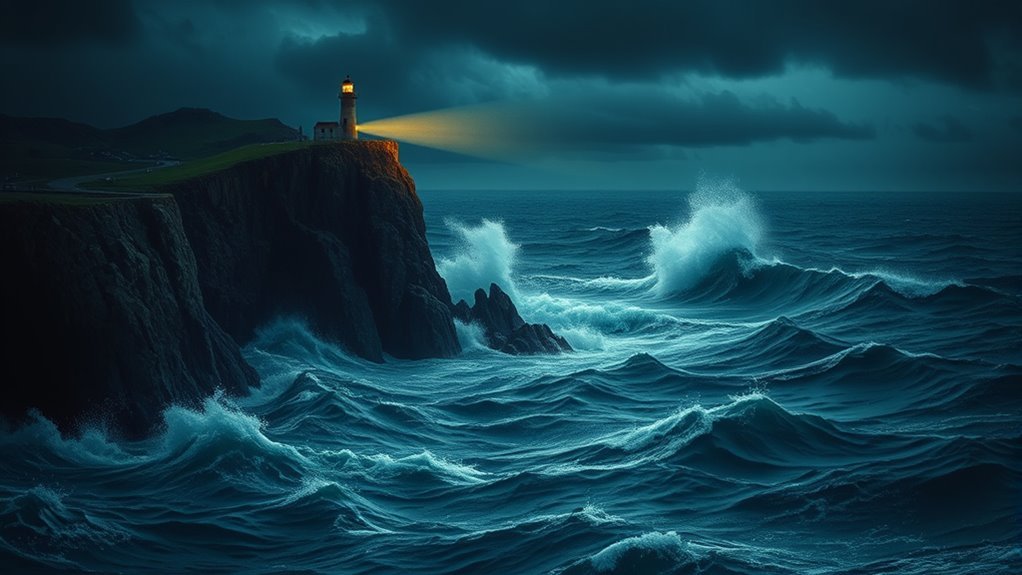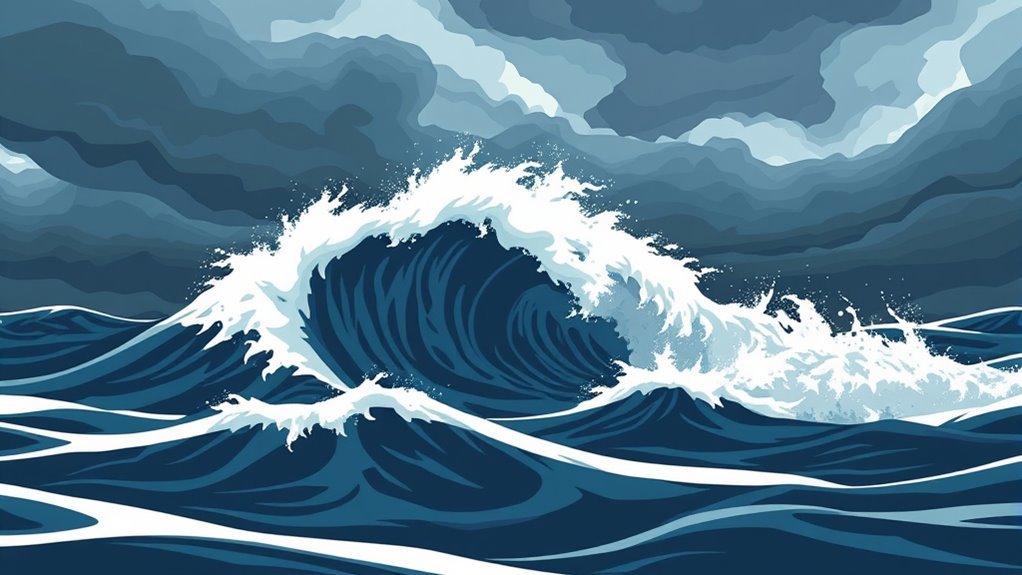Squalls have considerably shaped artistic and cinematic depictions of storms. They serve as powerful metaphors for human emotion, conveying turmoil and conflict. Iconic artworks reflect the duality of destruction and renewal intrinsic in squalls. In film, dynamic techniques improve the emotional impact of storm scenes, echoing characters' internal struggles. As representations have evolved, modern media employs advanced technology for hyper-realistic portrayals. This progression highlights the enduring influence of squalls on storytelling and artistic expression. Further revelations await exploration.
Main Points
- Squalls symbolize emotional turmoil and renewal, influencing artists and filmmakers to depict storms as metaphors for human struggles and complexities.
- Iconic artworks and films utilize squalls to showcase the dramatic interplay between light and dark, enhancing thematic depth and emotional resonance.
- Dynamic cinematic techniques, like camera movement and sound design, capture the chaotic nature of squalls, elevating viewer engagement and emotional impact.
- Squalls serve as catalysts for character development, revealing vulnerabilities and evolving relationships in both visual art and narrative storytelling.
- Advances in technology, including CGI, have transformed squall representations, creating immersive experiences that reflect modern emotional and societal contexts.
The Historical Significance of Squalls in Art
Although often overlooked, squalls have played a substantial role in the evolution of artistic expression throughout history. These sudden, intense weather events have served as powerful metaphors, reflecting human emotions and the tumultuous nature of existence.
Artists have frequently captured the dramatic interplay between light and dark during squalls, utilizing contrasts to evoke feelings of chaos and serenity.
In various cultures, squalls symbolize both destruction and renewal, making them notable motifs in art that investigate the duality of human experience. Ancient seafaring communities depicted squalls in their art to illustrate the hazardous unpredictability of nature, serving as cautionary tales.
During the Romantic era, artists embraced squalls as representations of sublime beauty, emphasizing the emotional impact of nature's fury. Consequently, squalls have transcended mere meteorological phenomena, becoming essential to the narrative of human creativity and the investigation of emotional terrains throughout artistic history.
Iconic Paintings Featuring Squalls
While storms often evoke fear and chaos, iconic paintings featuring squalls capture their intrinsic drama and beauty, showcasing the skill of artists in conveying the emotional weight of such turbulent moments.
These works often depict the violent interplay between nature and humanity, illustrating how squalls can create both awe and danger. Artists have employed various techniques to emphasize the ferocity of these storms, utilizing contrasting colors and dynamic compositions.
Notable examples include:
- J.M.W. Turner's "The Shipwreck" – This painting portrays a ship battling against a violent storm, highlighting the struggle of man against nature.
- Caspar David Friedrich's "The Sea of Ice" – Featuring a ship trapped in ice, it evokes feelings of isolation and despair amidst natural chaos.
- Winslow Homer's "The Gulf Stream" – This piece illustrates a lone man in a small boat, surrounded by tumultuous waters, symbolizing human vulnerability in the face of nature's might.
The Role of Squalls in Literature
Squalls serve as powerful symbols in literature, often representing turmoil both in nature and within human emotions.
In poetry, they evoke vivid imagery that elevates the emotional terrain and improves thematic depth.
Additionally, their sudden onset can create narrative tension, propelling characters into conflict and transformation.
Squalls in Poetry
Stormy squalls serve as powerful symbols in poetry, often representing turbulence both in nature and human emotion. Poets frequently employ these storms to evoke feelings of chaos, conflict, and transformation within their work.
The imagery of squalls not only enriches the text but also invites readers to investigate deeper meanings and connections.
- Emotional Turbulence: Squalls mirror internal struggles, highlighting the complexity of human feelings.
- Nature's Fury: The violent energy of squalls serves as a metaphor for uncontrollable forces in life.
- Catalyst for Change: Often, squalls signify moments of upheaval that lead to personal or societal transformation.
Through these elements, squalls become essential to the investigation of themes such as conflict, resilience, and renewal in poetry.
Narrative Tension Creation
In literature, squalls often emerge as critical elements that intensify narrative tension and propel character development.
These sudden and violent storms serve as metaphors for internal conflict, reflecting characters' emotional turmoil. Authors strategically deploy squalls to interrupt routine, forcing characters to confront external challenges that mirror their inner struggles.
The unpredictability of a squall can create suspense, as readers anticipate the outcome of both the storm and the characters' responses. By placing characters in dangerous situations, writers examine themes of resilience and transformation.
Additionally, the aftermath of a squall can lead to moments of reflection, allowing characters to evolve and adjust.
In the end, squalls not only elevate dramatic tension but also serve as catalysts for significant character growth.
Cinematic Techniques for Depicting Squalls

Capturing the raw intensity of squalls on screen requires a masterful blend of cinematic techniques that raise both visual and auditory experiences. Filmmakers employ various methods to effectively convey the chaotic nature of these storms, ensuring that audiences feel the storm's ferocity.
- Dynamic Camera Movements: Utilizing handheld or crane shots, directors can mimic the erratic motion of the wind and rain, creating a visceral sense of disorientation that mirrors a squall's unpredictability.
- Sound Design: Layered soundscapes, incorporating howling winds, crashing waves, and heavy rain, immerse viewers in the storm's atmosphere, enhancing its threatening presence.
- Lighting Techniques: Strategic use of strobe lights or rapid shifts in brightness can simulate lightning strikes, enhancing the drama and urgency associated with squalls while providing visual cues that heighten tension.
Together, these techniques forge an impactful representation of squalls, enhancing the storytelling experience in cinema.
Emotional Impact of Squalls in Film

The emotional impact of squalls in film often manifests through the visual aesthetics of turmoil, where chaotic weather mirrors internal struggles.
Nature's fury serves as a powerful symbol, reflecting characters' conflicts and driving their development.
As storms rage on screen, they not only heighten tension but also reveal deeper truths about the human experience.
Visual Aesthetics of Turmoil
Turbulence often serves as a powerful metaphor in film, embodying both external chaos and internal conflict. The visual aesthetics of squalls improve this metaphor, creating a gripping atmosphere that resonates with audiences. Filmmakers utilize various techniques to depict these tumultuous moments, enriching the narrative's emotional depth.
- Cinematography: Dynamic camera angles and rapid movements mirror the unpredictability of storms, heightening viewer tension.
- Lighting: Stark contrasts between light and shadow evoke feelings of dread and anticipation, reflecting the emotional turmoil of characters.
- Sound Design: The incorporation of thunder, wind, and rain intensifies the sensory experience, immersing the audience in the chaos and enhancing emotional responses.
Together, these elements forge a visceral connection between the viewer and the unfolding turmoil.
Symbolism of Nature's Fury
Nature's fury serves as a vivid symbol of emotional turmoil, reflecting the characters' inner struggles and conflicts. In film, squalls often manifest as a visceral representation of chaos, mirroring the turmoil faced by protagonists.
The intensity of a storm can mirror feelings of rage, despair, or confusion, providing a backdrop that heightens the emotional stakes of a narrative. As the winds howl and the skies darken, audiences are invited to perceive not just the physical danger, but also the psychological battles unfolding on screen.
This powerful imagery evokes empathy, allowing viewers to connect deeply with characters as they maneuver through their own storms. In the end, the depiction of storms transcends mere spectacle, becoming a poignant exploration of the human condition.
Character Development Through Conflict
While storms often serve as dramatic backdrops, they also play an essential role in character development by forcing individuals to confront their deepest fears and unresolved issues.
Squalls act as catalysts for transformation, revealing the vulnerabilities and strengths of characters in high-pressure situations. This emotional turmoil often leads to significant personal growth, as characters are compelled to maneuver their internal conflicts amid the chaos.
Key aspects of this development include:
- Fear Confrontation: Characters face their anxieties, leading to moments of self-discovery.
- Relationship Dynamics: Storms may test bonds, illuminating underlying tensions or deepening connections.
- Resilience and Growth: Characters emerge with newfound strength, shaping their identities for future challenges.
This interplay between external conflict and internal evolution enriches narrative depth.
Symbolism and Themes Associated With Squalls
Squalls, with their sudden onset and fierce intensity, often serve as powerful symbols in artistic and cinematic narratives. They represent chaos and unpredictability, mirroring emotional turmoil and internal conflict faced by characters. In literature and film, squalls can symbolize the abrupt disruptions in life, acting as catalysts for transformation or revelation.
Thematically, squalls evoke a sense of foreboding, illustrating the duality of nature's beauty and ferocity. They prompt reflections on humanity's vulnerability against the forces of nature, reinforcing existential themes of powerlessness and resilience.
Additionally, squalls can signify cleansing, suggesting that after the storm, clarity and renewal may follow. Through these complex representations, artists and filmmakers utilize squalls to deepen emotional resonance, imbuing their works with layers of meaning.
In the end, these stormy phenomena illuminate the complexities of human experience, serving as a poignant backdrop for exploration of life's unpredictable nature.
The Evolution of Squall Representation in Modern Media
As artistic mediums have evolved, so too has the representation of squalls in modern media, reflecting societal shifts and advancements in technology. Historically depicted through painting and literature, squalls have shifted into dynamic visual experiences in film and digital art. This evolution highlights not only the changing aesthetic preferences but also the increasing sophistication of special effects and animation.
The following aspects illustrate this transformation:
- Realism: Advances in CGI allow for hyper-realistic portrayals of squalls, enhancing viewer immersion.
- Interactivity: Video games and virtual reality have introduced participatory experiences, enabling audiences to engage with squall scenarios directly.
- Symbolism: Modern narratives often use squalls as metaphors for internal conflict, reflecting contemporary societal issues and emotional turbulence.
Common Questions
How Do Squalls Differ From Hurricanes or Typhoons?
Squalls are brief, intense bursts of wind and rain, typically lasting minutes, whereas hurricanes and typhoons are large, persistent storms that can last days and comprise a wider area, causing more considerable damage and disruption.
What Scientific Factors Contribute to the Formation of Squalls?
The formation of squalls is influenced by several scientific factors, including atmospheric instability, sudden shifts in wind patterns, and the presence of moisture. These elements combine to create intense, brief storms defined by strong winds and precipitation.
Are Squalls More Common in Certain Geographical Areas?
Squalls occur more frequently in coastal regions, particularly during warmer months. Areas with considerable temperature variations and moisture, such as the Gulf Coast and the Mediterranean, experience heightened squall activity due to prevailing weather patterns.
How Do Artists Choose Colors to Depict Squalls?
Artists often select colors based on emotional resonance and atmospheric effects. Dark blues and grays evoke turmoil, while bright flashes of white or yellow can signify lightning, creating a dynamic interplay that captures the essence of squalls.
What Real-Life Events Inspired Specific Artworks Featuring Squalls?
Real-life events such as intense storms, shipwrecks, and coastal disasters often inspired artists. These dramatic moments captured their imagination, leading to powerful artworks that reflected the tumultuous nature of squalls and their emotional resonance.

